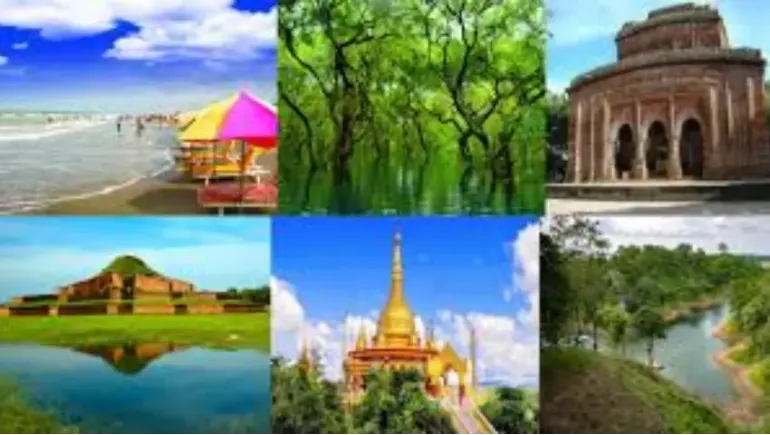
Heritage tourism is a gateway to a country's past, culture, and traditions. In Bangladesh, a land brimming with centuries-old monuments and cultural landmarks, reviving heritage tourism is not just an economic opportunity but also a way to preserve its rich history. This article delves into the importance of heritage tourism in Bangladesh, highlights key destinations, and explores actionable steps to rejuvenate this sector.
Heritage tourism allows visitors to experience the culture, architecture, and traditions of a destination. In Bangladesh, where history is intricately woven into the fabric of everyday life, heritage tourism can. Tourism creates jobs and stimulates local economies. According to the World Travel & Tourism Council, tourism contributed 4.4% to Bangladesh's GDP in 2022, with significant potential for growth. Increased tourism can fund the maintenance and restoration of historical landmarks, preventing them from falling into disrepair. Heritage tourism fosters national pride and global recognition of Bangladesh's unique cultural assets.
Panam City, located in Sonargaon, once served as the capital during the Bengal Sultanate. Its 52 historic buildings, featuring colonial and Mughal architectural influences, make it an extraordinary destination. However, despite its potential, Panam City faces neglect, with crumbling structures and inadequate conservation efforts. The government has initiated restoration projects under the Ministry of Cultural Affairs. However, greater involvement from private sectors and NGOs is necessary to restore Panam City to its former glory.
A UNESCO World Heritage Site, Bagerhat in Khulna boasts the Sixty Dome Mosque (Shat Gambuj Masjid) built by Khan Jahan Ali in the 15th century. This mosque is an architectural marvel, showcasing terracotta artistry and Islamic design. Rising salinity levels and inadequate visitor facilities are deterring tourism. Revamping the infrastructure and promoting eco-tourism in the Sundarbans, located nearby, could make Bagerhat a dual-attraction destination.
Located in Bogra, Mahasthangarh is the earliest urban archaeological site in Bangladesh, dating back to at least the 3rd century BCE. Its ancient ruins and museum attract history enthusiasts. To increase tourism, Mahasthangarh needs digital guides, better transportation, and partnerships with educational institutions for study tours.
This 17th-century Mughal fort in Dhaka remains one of the city's top attractions. The unfinished fort includes a mosque, a tomb, and lush gardens. Though popular, the fort requires better crowd management, improved signage, and enhanced storytelling through AR (Augmented Reality) technology.
Located in the Naogaon District, Paharpur is an ancient Buddhist archaeological site, and its ruins are listed as a UNESCO World Heritage Site. The site features the remnants of a vast Buddhist monastery, which was one of the most important centers of learning in the ancient Bengal region.
Despite its potential, heritage tourism in Bangladesh faces significant hurdles. Many historical sites suffer from neglect due to insufficient funding for maintenance and restoration. Rapid urbanization often encroaches upon heritage sites, threatening their preservation. Many sites remain unknown to both local and international tourists due to poor promotional efforts. Limited access to transportation, lack of nearby accommodations, and minimal visitor amenities discourage tourists.
Collaboration between the government and private entities can drive funding and expertise for restoration projects. For example, partnerships could enhance tourist facilities in Panam City or introduce virtual tours for Lalbagh Fort. Investing in digital platforms to promote heritage sites can attract tech-savvy travelers. AR and VR technologies can enhance visitor experiences by bringing historical events to life. For example, AR-guided tours could recreate battles or royal ceremonies at historical forts.
Incorporating sustainability ensures that heritage tourism benefits local communities and minimizes environmental impact. For instance, eco-friendly transport to Bagerhat and community-led souvenir shops in Mahasthangarh can add value. Local communities should be actively involved in managing heritage tourism. Training programs for locals as tour guides or cultural performers can provide employment while enriching visitor experiences.
Countries like India and Sri Lanka have excelled in leveraging heritage tourism. Jaipur's restoration of Hawa Mahal and Colombo's promotion of Galle Fort are examples Bangladesh can emulate. By learning from these models, Bangladesh can create heritage tourism circuits that combine multiple destinations for a holistic experience.
Bangladesh is a treasure trove of historical and cultural wealth waiting to be rediscovered. Reviving heritage tourism can preserve the nation's legacy while providing significant economic and social benefits. By prioritizing restoration, marketing, and sustainable practices, Bangladesh can transform its heritage sites into globally recognized attractions. Investing in heritage tourism is not just about the past—it’s about building a sustainable future where history and progress coexist. Let us celebrate Bangladesh’s rich tapestry of culture and history, one tourist at a time.












Comments
There are no comments for this Article.